5 Lesser-Known Upcoming Residential Hotspots In The Singapore Property Market
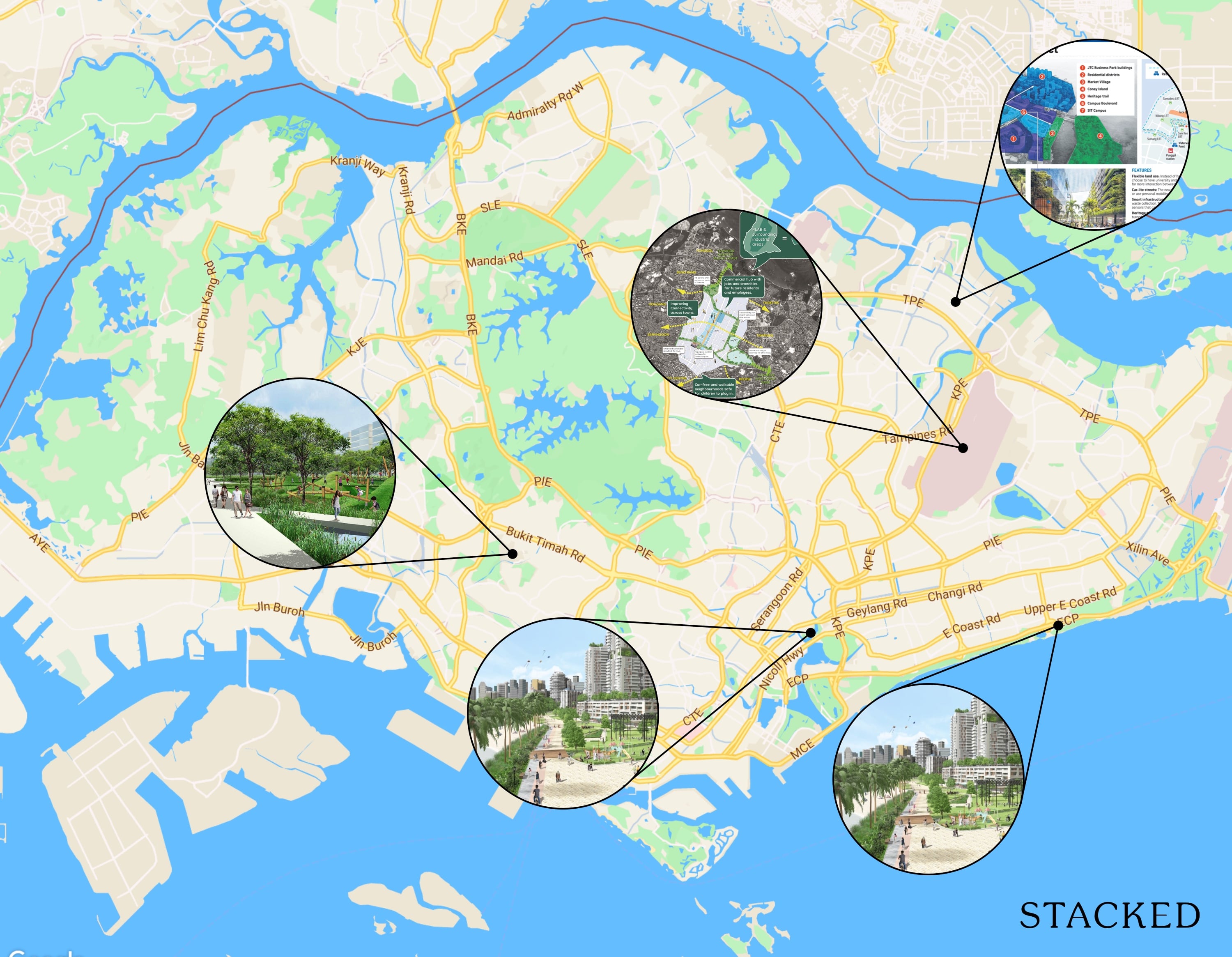
Get The Property Insights Serious Buyers Read First: Join 50,000+ readers who rely on our weekly breakdowns of Singapore’s property market.
A seasoned content strategist with over 17 years in the real estate and financial journalism sectors, Ryan has built a reputation for transforming complex industry jargon into accessible knowledge. With a track record of writing and editing for leading financial platforms and publications, Ryan's expertise has been recognised across various media outlets. His role as a former content editor for 99.co and a co-host for CNA 938's Open House programme underscores his commitment to providing valuable insights into the property market.
While the usual prime spots remain unchanged (Orchard Road, Marine Parade, etc.), fresh developments have drawn the spotlight to other neighbourhoods as well. There are some upcoming property hotspots, which have flown under the radar so far. For investors or home buyers looking far ahead, here are the most under the radar neglected areas:
1. Holland Plain
The URA development plan for Holland Plain was supposed to be launched this year (2021), although we haven’t heard much about it. It’s possible that plans are currently on hold due to Covid-19.
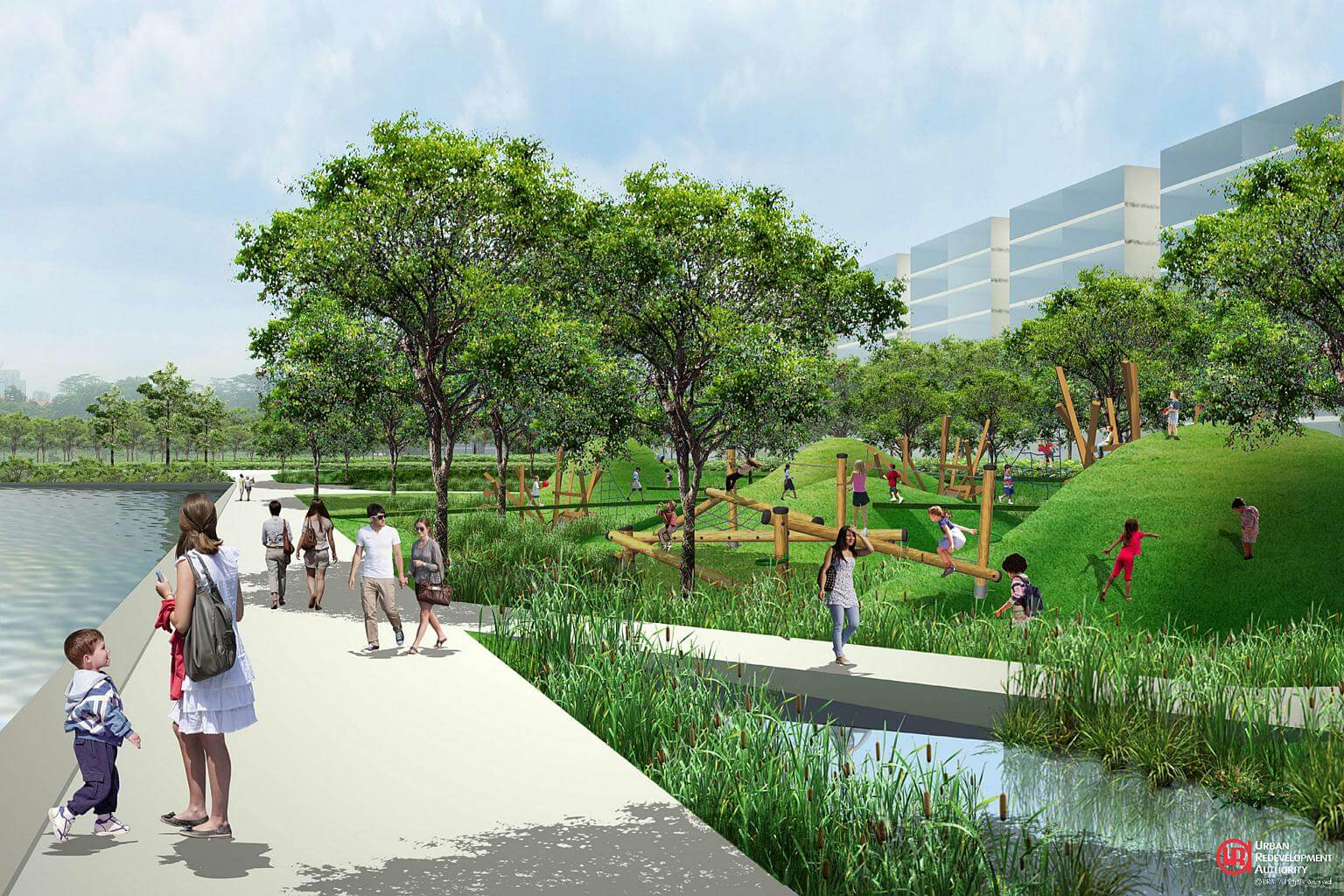
This is currently the site of the Bukit Timah First Diversion Canal. It’s an 800-metre stretch under the PUB’s Active, Beautiful, and Clean (ABC) project. Once complete, it will be a lifestyle park and is expected to include skyrise greenery (hopefully, something more innovative than condos with more planter boxes). For those worrying about flood issues in the future, $500m has been spent to improve the drainage in these areas.
Some of the other planned highlights here would be the green routes that will enable residents to get to the King Albert Park MRT station, the rail corridor and the park connector along the Bukit Timah First Division Canal. The current 1.5m wide footpaths at Holland Plain will also be upgraded to 3.5m wide ones instead – so cyclists and joggers will definitely be very happy with that.
Holland Plain is situated between Bukit Timah and the Botanic Gardens, so it’s nestled within a substantial “green stretch” for homebuyers who loathe glass and concrete. The total land space is 34 hectares, and it’s predicted to yield around 2,500 new homes.
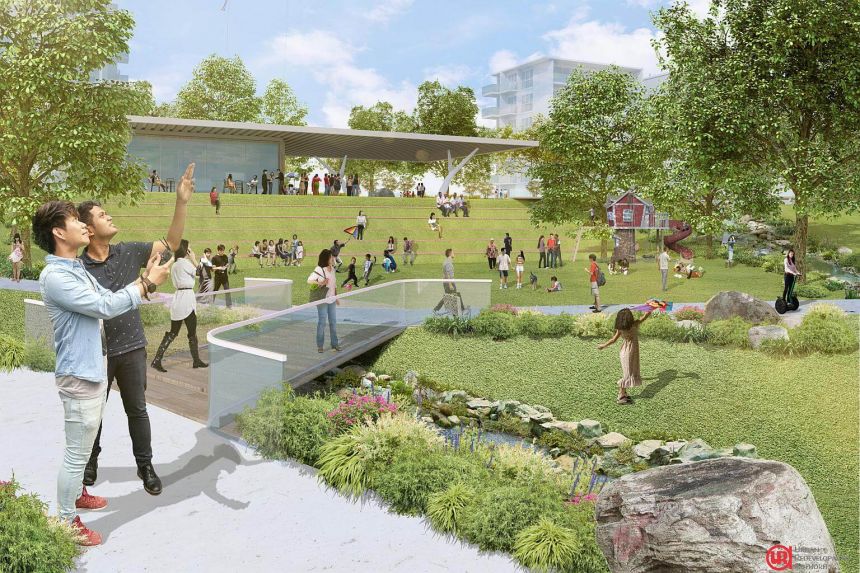
Why is it a hot spot?
Holland Plain is close to the Rail Corridor, Singapore’s counterpart to New York’s Highline Park. Built along former train tracks, this is set to be a lifestyle as well as a retail area (the Rail Mall is already open, at the time of writing).
Besides this, Holland Plain is set to be a car-lite area, with an emphasis on garden living. Depending on pricing, it may also offer a cheaper alternative to projects in Bukit Timah proper; without losing any of the park space and greenery.
2. The area around Paya Lebar Airbase
When we say Paya Lebar is a hot spot, most people assume we refer to Paya Lebar Quarter (PLQ). However, PLQ is already a done deal. The next part of Paya Lebar to focus on is the area surrounding Paya Lebar Airbase.
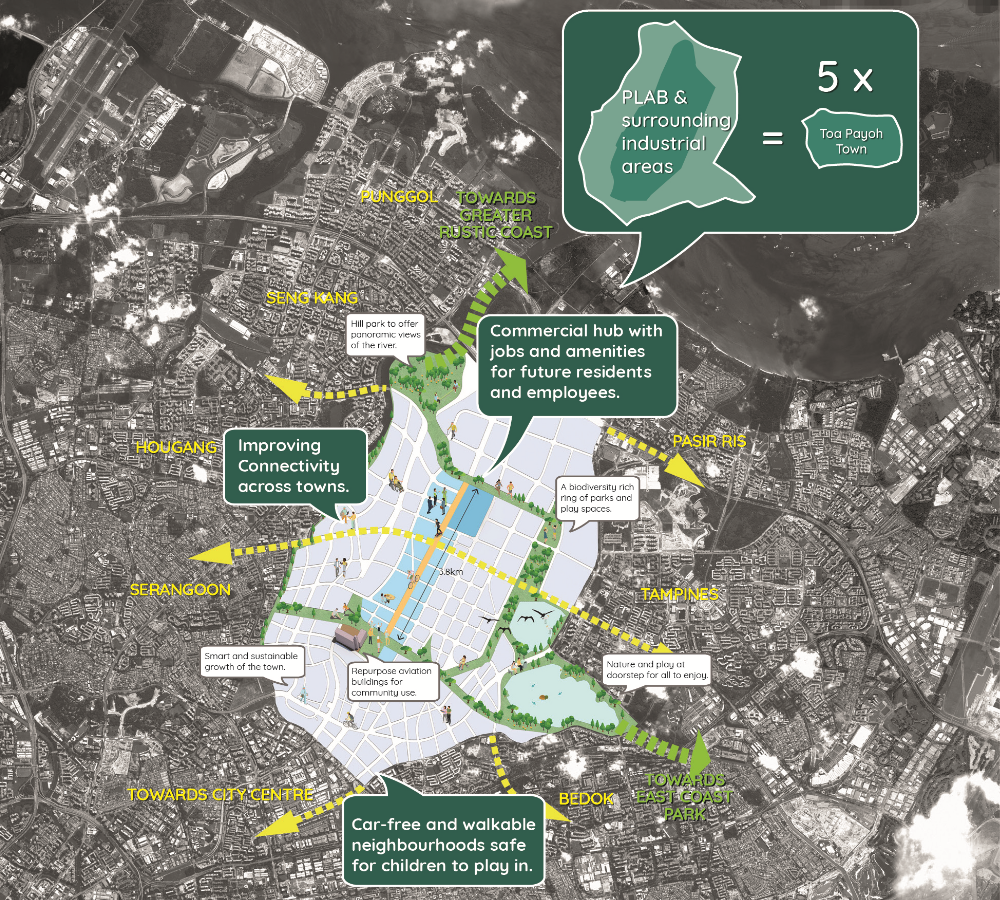
When the airbase moves in 2030, it will free up room for a whole new town. Already, URA has plans envisioned for the area. Part of the plan involves a “runway boulevard” stretching 3.8 kilometres; this stretch will include offices, lifestyle areas, retail, residential, etc.
The designated area for the change is huge, around five times the size of Toa Payoh; and it also forms a connecting point between Serangoon and Tampines.
Why is this a hotspot?
Right now the area surrounding the airbase is mostly just industrial, with nothing of interest to speak of. This will put most investors in mind of Jurong and its subsequent transformation – from a simple bunch of workshops and warehouses to today’s retail powerhouse with JEM, J-Cube, etc.
Besides the obvious benefits, investors will also be monitoring nearby projects and Gross Plot Ratio (GPRs). This is because moving the airbase could free up height restrictions for certain nearby condos, or relieve existing projects of noise pollution.
You can expect that investors will be quick to jump in when the first developments show up.
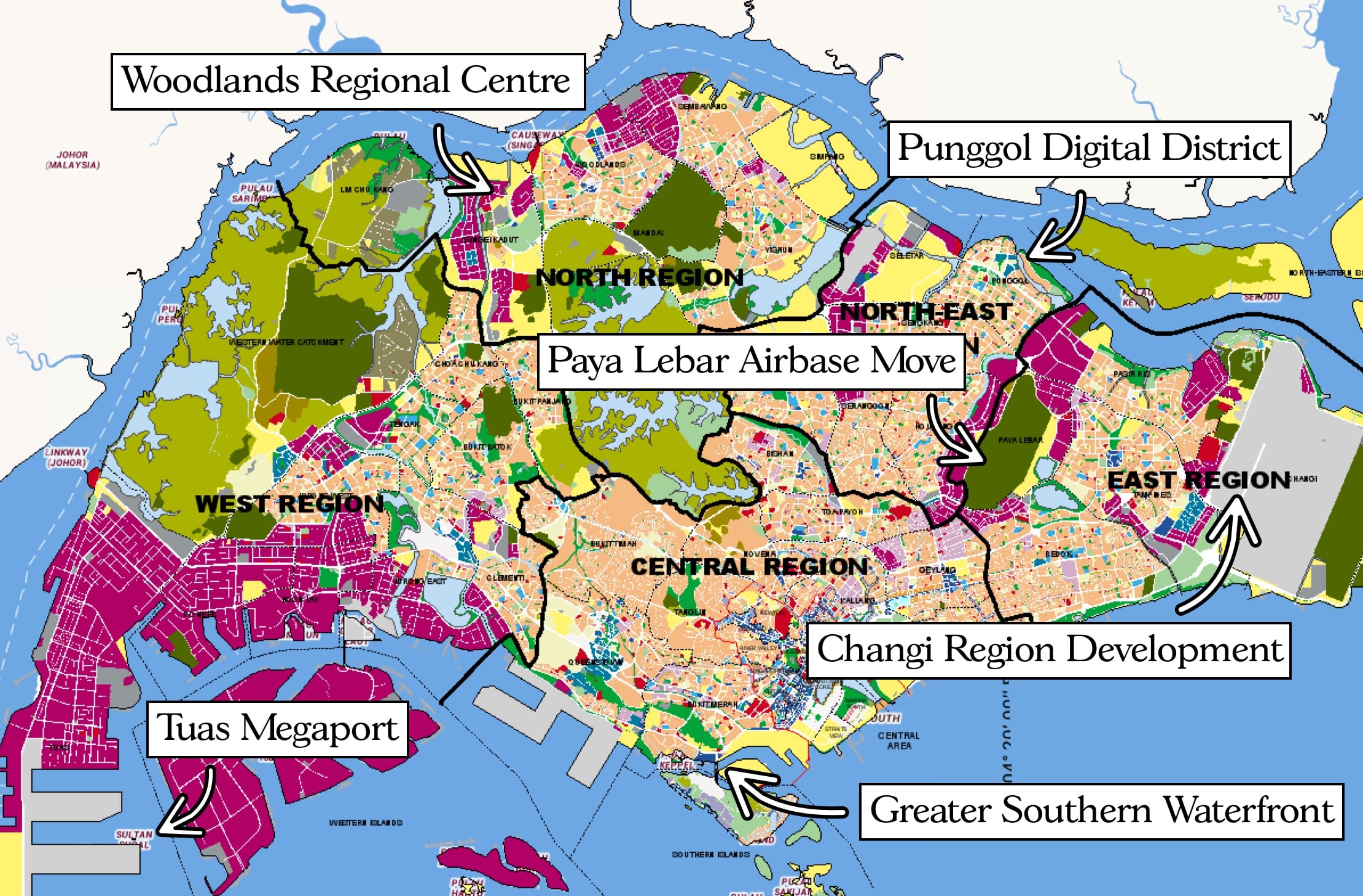
Property Market Commentary6 Major Upcoming Changes You Need To Know In The URA Master Plan
by Ryan J. Ong3. Kampong Bugis
Despite the name, this is really more a development in Kallang, not Bugis.
URA envisions Kampong Bugis as a waterfront area, at the mouth of the Kallang River. It spans around 8.29 hectares and is expected to yield 4,000 new homes. In addition, there’s about 50,000 sq. m. of given over to retail, serviced apartments, and office space.
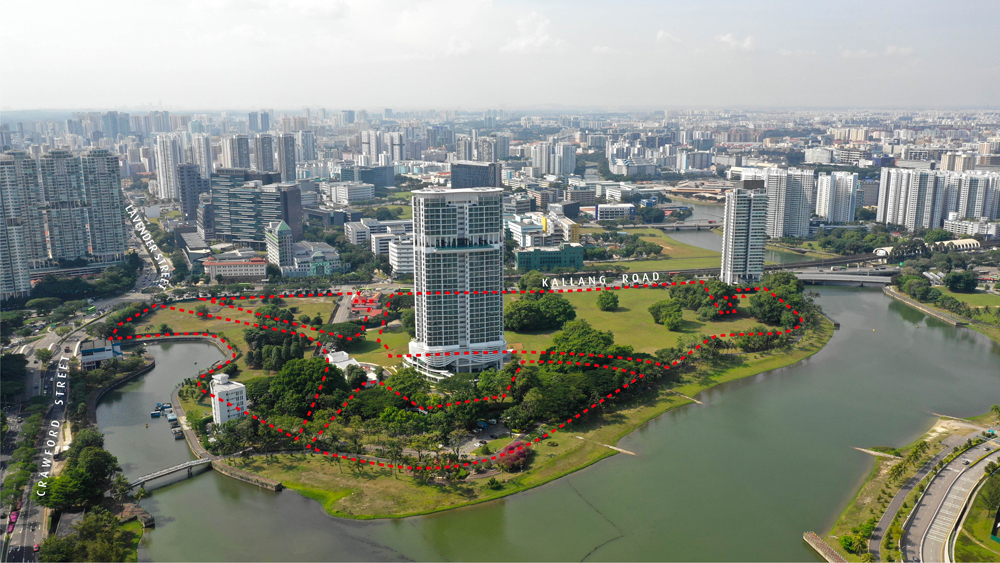
It’s worth noting that the area may be within walking distance to Kallang MRT, at around eight to 10 minutes (although we can’t confirm this yet). It is planned to be a car-lite precinct so easier walking routes will be planned such as a new underpass and footbridges will help to ensure direct access to the MRT stations.
Kampong Bugis will also be a boon to existing condos in this area (The Riverine and Kallang Riverside), as they’ll end up with major amenities right on their doorstep. Not to mention, these are freehold too. We do expect interest in these resale properties to go up, as Kampong Bugis develops.
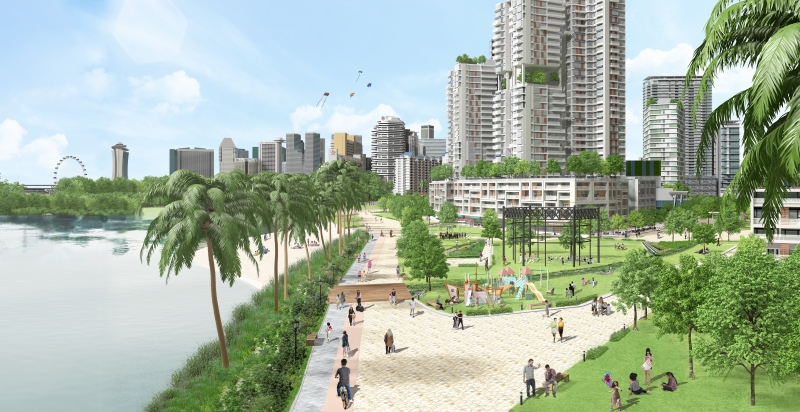
Why is this a hot spot?
Kampong Bugis builds on the development of the Kallang Sports Hub and accompanying Kallang Wave Mall (both of these are within a seven-minute drive). Coupled with easier walking access to Kallang MRT, this will be a waterfront area that’s accessible and convenient.
The existing Kallang Riverside Park will also be transformed, not just with the greenery, but the planned upgrades to keep the waters clean. There will be a host of greenery and water-sensitive features that will clean the stormwater runoff before it is released into the reservoir.
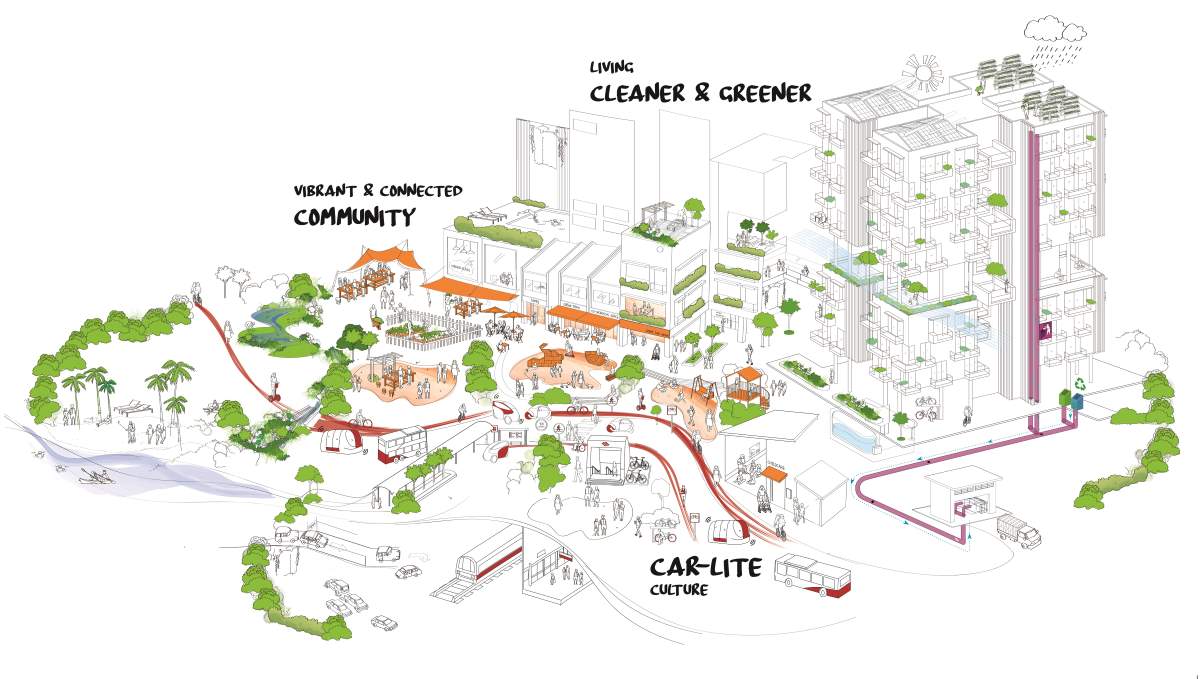
In addition, there will also be a district-level pneumatic waste conveyance system. In other words, a cleaner and easier way to collect waste so that you’d have fewer rubbish collection trucks that need to move around. But that’s probably not what most people would care about – the most tantalising upgrade would be the addition of community spaces. These include things like local bakeries, childcare centres, tranquil courtyards, and playgrounds, which will help a great deal in making the area a lot more liveable.
More from Stacked
This $1.5M Bukit Timah Executive HDB Flat With 62-Years Lease Left Just Set A Record: Here’s Why
If you're keeping track of million-dollar HDB transactions, here's one to add to your list: a Bukit Timah executive maisonette…
Kallang has gone under the radar, despite substantial improvements to the area. The inclusion of office space, as well as waterfront residential, is likely to tip the spotlight back to this area soon.
4. Bayshore
Bayshore offers seafront living along East Coast Beach, but has long been plagued by accessibility issues. This is resolved with the upcoming Bayshore MRT station. This is the largest of the upcoming new hotspots, at close to 60 hectares. This provides for around 12,500 new homes, and may include both public as well as private housing. Although it must be said at this point that various experts have indicated that the planned number of new homes may strain infrastructure in the area.
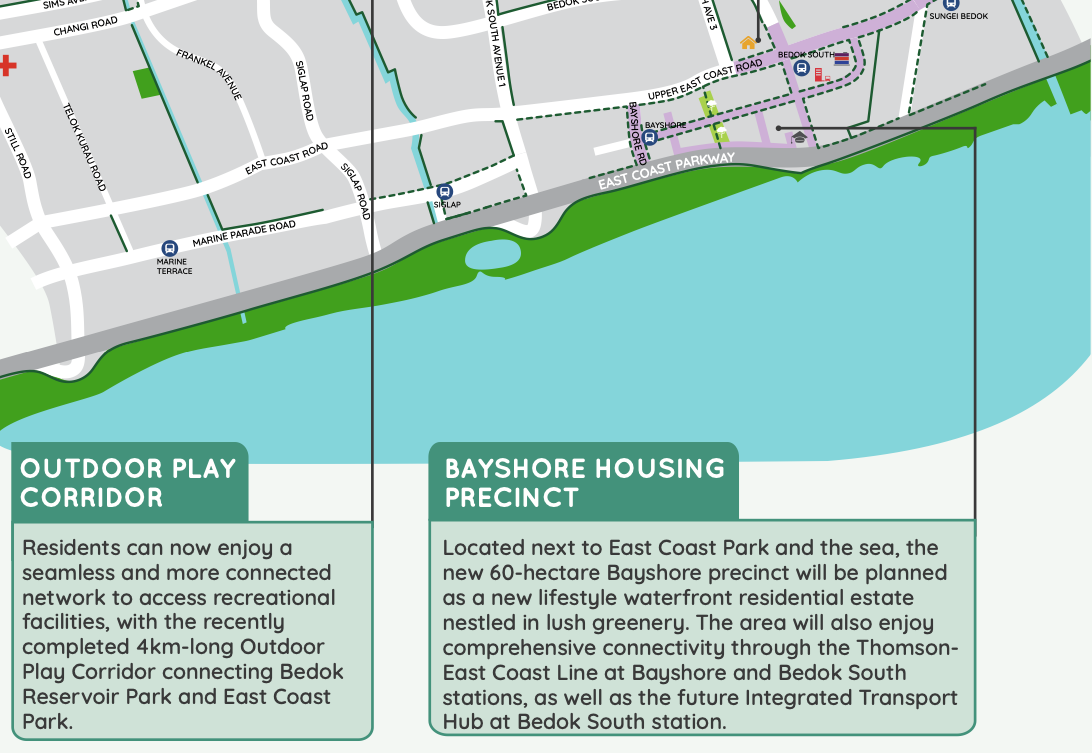
Most of the changes will centre along a one-kilometre “main street”, running past the existing cluster of condos (The Bayshore, Bayshore Park, and Costa Del Sol). Apart from the usual restaurants and shops, this stretch will include childcare and eldercare facilities (which lends credence to the rumours of having BTO flats nearby).
Mind you, Bayshore as it is right now is quite devoid of amenities and is only really known for seaside living.
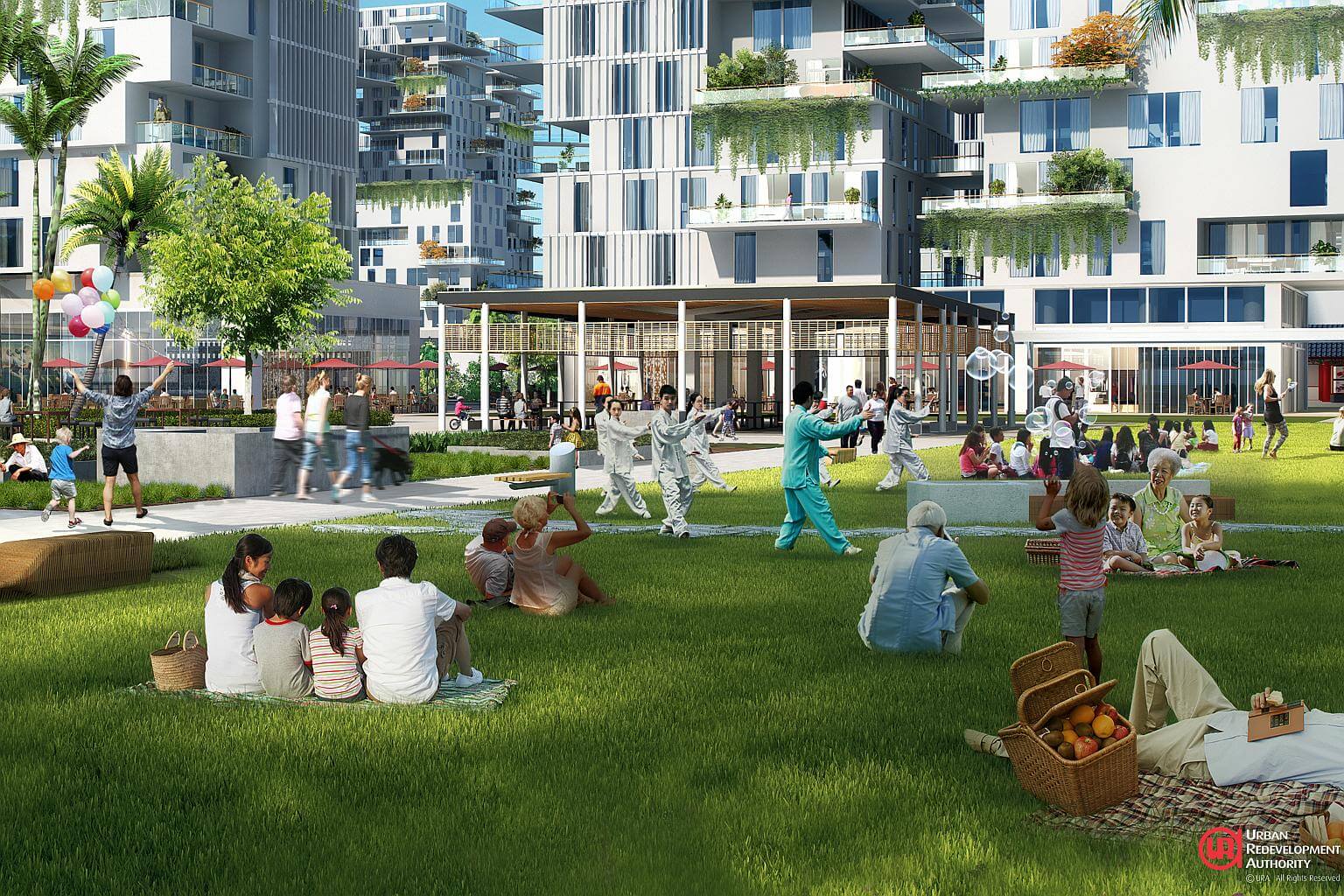
Like Kampong Bugis, the Bayshore area is targeted to be another car-lite precinct, as most of the homes here will be within 400m of an MRT station due to the upcoming Thomson East-Coast MRT line.
Do remember though, that a car-lite precinct does mean that it will attract a different crowd (it will take an extended period of time to wean Singaporean’s off their favourite cars), and so families with young children and elderly parents might stay away from such an area. So developers will likely be looking to develop smaller units for singles and younger couples and perhaps even a build-to-rent model.
Why is this a hotspot?
Seafront living in the east has proven demand, since the days of Marine Parade in the 1960s. This area is close to the expatriate enclave of Katong, and the condos in Bayshore right now have a large expat population – further development of the area is likely to draw the interest of landlords.
Besides this, Bayshore will finally have its own MRT station, this solving the longstanding accessibility issue. It could also form a cheaper alternative to District 15, which is known for luxury condos like Meyer Mansion; these have typically been priced far beyond the average Singaporean.
It’s also worth noting that for the Bayshore district, there is a blue plot planned at Bedok South station (basically an integrated development). So for those looking out for such (given the success of Canninghill Piers and Pasir Ris 8) might want to keep an eye out for this one.
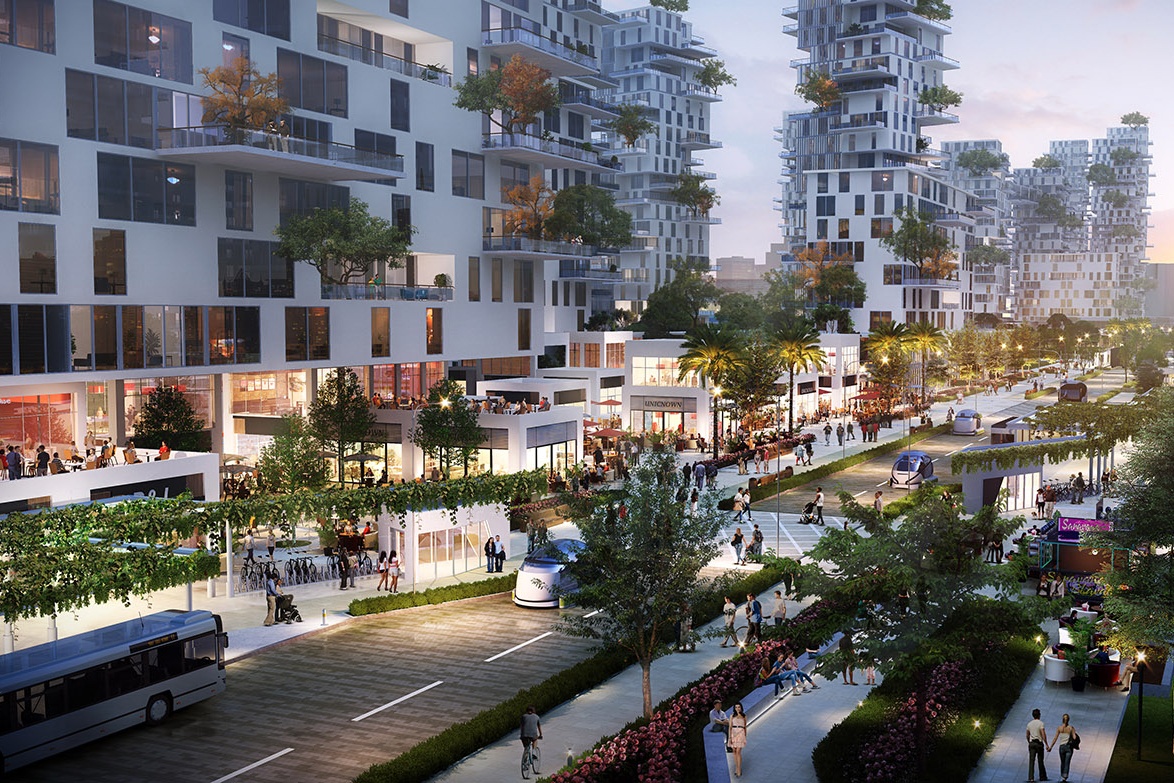
What will be cool though would be the planned 1km Bayshore street – with wider pavements for a better experience when walking or cycling. It will be lined with trees, shops, cafes and parks and will be connected to different courtyard spaces nearby that offer a range of facilities.
5. Punggol
It’s strange to be calling Punggol a hotspot, as it’s long been considered an “ulu” area with cheap housing. Nonetheless, the market reflects a different reality:
In April 2021, a premium 5-room flat at Treelodge@Punggol sold for $910,000. This made it one of 23 flats in non-mature estates to fetch a price above $800,000. And just recently, another loft unit within the same development went for $970,000!
Also, prior to this in 2019. A 5-room loft flat at Punggol Sapphire sold at $910,000.
Now to be clear, these weren’t “normal” flats. The unit at Treelodge was a top-floor unit with two storeys, that was only nine years old. The unit at Punggol Sapphire was one of only 37 loft flats, which can reach up to 1,600+ sq. ft.
Nonetheless, these are prices that, just around five years ago, would be difficult to envision for Punggol.
You may recall, for instance, that many buyers felt Piermont Grand EC (located at Sumang Walk) was too expensive; prices had averaged just $1,147 psf once sales ended in October ’21. A common consensus was that anything above $1,000 psf was too high for Punggol. And yet, here we are today with Piermont Grand sold out.
Why is this a hotspot?
There are two main factors elevating Punggol’s price.

The first and most significant is the Punggol Digital District (PDD). This will be a waterfront digital hub, which puts institutes like the Singapore Institute of Technology (SIT) close to tech companies of all sizes.
This coincides with the new Tech@SG program, aimed at accelerating the entry of tech workers – and entrepreneurs – into Singapore. This makes Punggol of interest to both homeowners as well as aspiring landlords.
The second factor is the impact of Watertown, an integrated development with a major retail component. The combination of Waterway Point, Punggol Waterway Park, etc. introduces some much-needed amenities in the area. Punggol is shaping up as a lifestyle enclave and is no longer considered as boring or inconvenient as in previous decades.
For more on these areas as they develop or hotspots across Singapore, follow us on Stacked. We’ll also provide in-depth reviews of new and resale properties alike, for the discerning home buyer.
If you’d like to get in touch for a more in-depth consultation, you can do so here.
Ryan J. Ong
A seasoned content strategist with over 17 years in the real estate and financial journalism sectors, Ryan has built a reputation for transforming complex industry jargon into accessible knowledge. With a track record of writing and editing for leading financial platforms and publications, Ryan's expertise has been recognised across various media outlets. His role as a former content editor for 99.co and a co-host for CNA 938's Open House programme underscores his commitment to providing valuable insights into the property market.Read next from Property Market Commentary

Property Market Commentary How The HDB Resale Market Performed In 2025, And What It Means For 2026 Prices

Property Market Commentary 4 Key Trends Reshaping Singapore’s New Launch Condo Market In 2026

Property Market Commentary When Renting In Singapore Is The Smarter Move — And Buying Can Wait

Property Market Commentary A Wave Of New HDB Resale Supply Is Coming In 2026: Here’s Where To Find Them
Latest Posts

Pro This 21-Year-Old Condo Didn’t Sell Out Initially, Yet Became A Top Performer

Homeowner Stories What I Only Learned After My First Year Of Homeownership In Singapore

Singapore Property News Why More Land Doesn’t Automatically Fix Housing In Singapore

On The Market Here Are The Cheapest 4-Room HDB Flats in Central Singapore You Can Still Buy From $490K

Editor's Pick Should We Buy An Old 99-Year Leasehold Condo To Live In: Will It’s Value Fall When The Lease Runs Out?

Pro How A Once “Ulu” Condo Launched In 1997 Became A Top Performer

Editor's Pick I Reviewed A New Launch 4-Bedroom Penthouse At Beauty World

Editor's Pick Why Singaporean Families Are Looking At This Landed Enclave From Around $4M

Singapore Property News Lentor’s First Condo Is Complete — The Early Profits May Surprise You

Property Advice We Own A $800K 1-Bedder And A $1.1M 3-Bedder: Is It Possible To Upgrade To A 4-Bedder Condo?

On The Market These Are Some Of The Cheapest 5-Room HDB Flats Left In Central Singapore

Pro This 698-Unit Ang Mo Kio Condo Launched At The Wrong Time — And Still Outperformed Peers

Singapore Property News $281.2M in Singapore Shophouse Deals in 2H2025 — But That Number Doesn’t Tell the Full Story

Property Investment Insights These Resale Condos In Singapore Were The Top Performers In 2025 — And Not All Were Obvious Winners

Singapore Property News CapitaLand–UOL’s $1.5 Billion Hougang Central Bid May Put Future Prices Above $2,500 PSF


